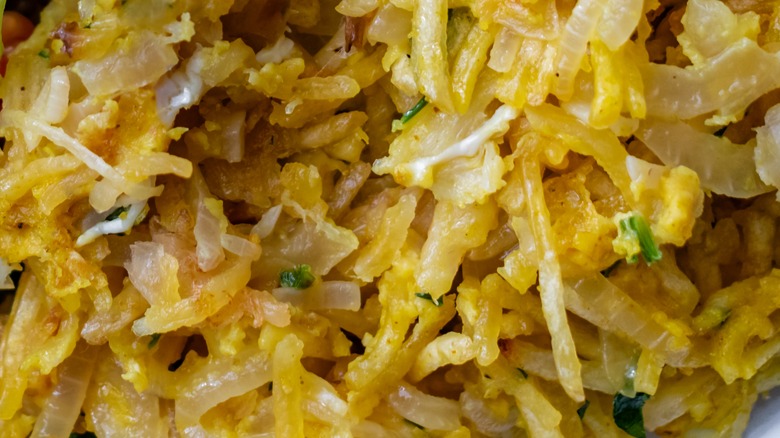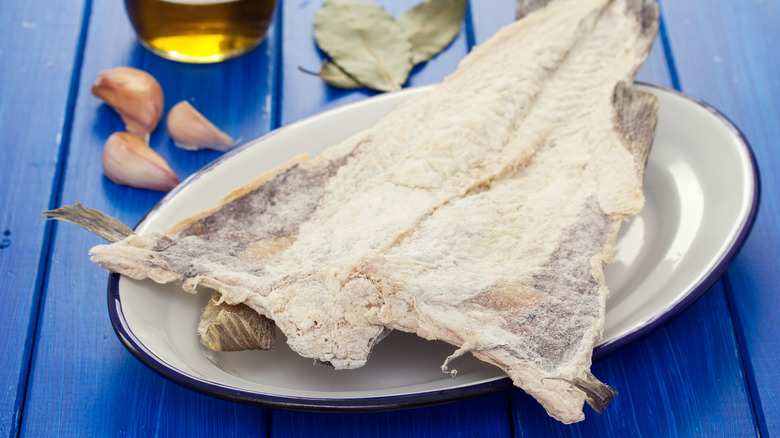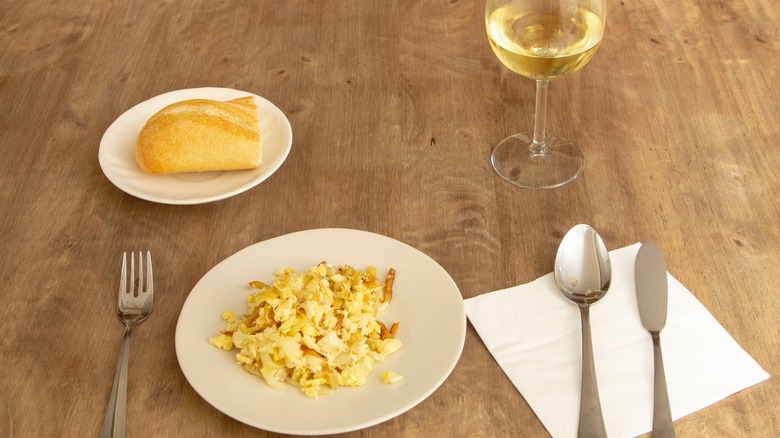The Portuguese Comfort Dish That Unites Salty Cod And Scrambled Eggs
While people today are able to eat foods from all over the world, all the time, countries still hold true to their national dishes. These iconic foods have histories as rich as their flavors, often showcasing regional ingredients and telling stories about the people who created (and continue to preserve) them. While American cuisine can be hard to pin down, there's no question that we're proud of our barbecue, burgers and hot dogs, and countless other foods influenced by our diverse population. Korea has beef bulgogi, Hungary has goulash, and England has roast beef and Yorkshire pudding (per National Geographic). Spain has paella, Canada's known for poutine, and Costa Rica's got ceviche — to name a few more, according to World Food Guide.
Often, these dishes celebrate ingredients that may be new to us, but they're also inspiring springboards into culinary frontiers. One such national dish is salted cod and scrambled eggs, or bacalhau à brás. This is the national dish of Portugal, and it's made with flakes of salted cod, fluffy eggs, and shoestring potatoes, as described by Food52's Stephanie Andrews. Jamie Oliver says, "it may look a bit bonkers," but he, Andrews, and many other food scene professionals concur that bacalhau à brás is Portuguese's premier comfort food and a delicious symbol of the country's connection to land and sea.
What's salt cod and how did it happen?
The national dish of Portugal revolves around a special ingredient. Salted cod or salt cod, which National Public Radio called, "the prosciutto of the sea," refers to dried, heavily salted slabs of Atlantic cod flesh whose leanness and abundance made it ideal for preservation by many nations along the Atlantic Ocean, NPR reports. Over time, the salt also helps cure the fish and develop deep umami flavors that make dishes it's added to work swimmingly (per NPR).
Taste of Lisboa writes that the Portuguese first encountered salted cod (not a native species) in 1497 Newfoundland, Canada. Until then, they'd been relying on stockfish — an unsalted, sun-dried fish innovated by the Vikings, Taste of Lisboa continues. Fish and eggs are actually a very old combination — one that isn't common on American menus. British seafood company Big Fish explains that the eggs' amino acids help us digest protein, and many cultures have egg and fish dishes that go beyond the mainstream brunch-y preparation of poached eggs and salmon. Two proteins are better than one, don't you agree? Healthline names cod as one of the healthiest fishes to eat and rightly calls eggs a superfood, so bacalhau à brás is a match meant to be.
How to buy and use salt cod
It takes a bit of worthwhile effort to find and prepare salt cod. Look for salted cod at your supermarket's seafood counter or order it online. NPR warns that salt cod is often mislabeled – lower quality products may actually be other white fish species like hake. They further explain that shoppers should seek out almost-white filets at least two inches thick on the large end that are sold in salt-packed wooden boxes. To prepare the salt cod for eating, NPR says to soak the fish in cold water for at least two days, always under refrigeration, and swap out the salt-infused water for fresh water two to three times daily –- and the duration depends on the size of the filets. NPR also advises not to salt your final dish without tasting it as the final saltiness of the cod varies considerably.
Short of traveling to the source, you can enjoy the unique characteristics of salt cod at home. You're on your way to preparing traditional dishes like Portuguese salted cod and eggs, Jamaican ackee and saltfish, and French salt cod and potato brandade. You can also make fried salt cod or salt cod fritters, and Mexican dishes like BBC Good Food's Mexican a la vizcaína, which also has pickled chilis and almonds. Rick Bayless of Frontera makes salt cod, tomato, and olive tacos. As long as you grasp the de-salting process, you'll have a succulent, firm, versatile fish with beautiful briny flavor for use in your favorite seafood-based recipes — including bacalhau à brás.


